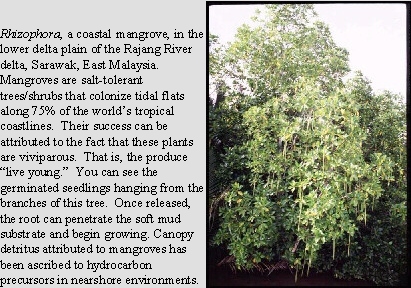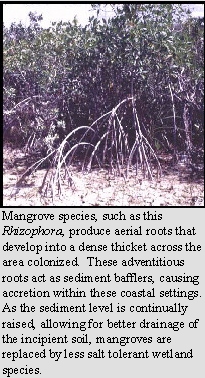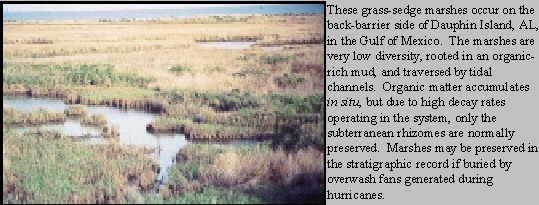BIOSTRATINOMIC PROCESSES IN COASTAL MARINE SETTINGS
Vegetation along the world's coastlines is related to the prevailing climate at each site.
Approximately 75% of all tropical coastlines are inhabited by mangrove (halophytic trees/shrubs)
taxa, whereas temperate coastlines are inhabited by salt-marsh grasses because mangroves are frost
intolerant.
Mangroves

Mangroves are pioneering plants that colonize tidal flats and other areas. They produce
subterranean and aerial (pneumatophores) roots. The timing of plant part loss is seasonal and
related to changes in salinity.
- Subaerial roots promote sedimentation due to their baffling and trapping effects.
- The density of the aerial roots is crucial in the reduction of
current and resultant sedimentation.
- Mangrove peat formation is dependent on the mangrove type and its
position within the tidal zone.

- Mangroves contribute to autochthonous peat, comprised mainly of intertwined rootlets
and soft (parenchymatous) parts of larger roots.
- Mangroves may contribute debris to allochthonous peat, which may be distinguished by
the presence of marine invertebrate shells intermixed with finely divided (comminuted
hash) plant debris.
Tidal flushing of mangrove biomass may result in the accumulation of lipid-rich cuticles in
nearshore marine areas; these accumulations are thought to have the potential for generation of
hydrocarbons.
Marshes
Salt-tolerant grasses and sedges occur in subtropical and temperate coastal zones and may be
intermixed with mangroves. The mangrove-marsh transition depends on the increased number of
frost-killing days. Aquatic and semi-aquatic plants inhabit marshes.
- Plants occupying marshes are instrumental in accreting sediment by trapping during tidal cycles.
- Sedimentation rates are high in low marshes (at or slightly below base level), whereas rates are
lower in high marshes (up to 1 m above base level, or above the high-tide level).
- Autochthonous and allochthonous (including algae) debris may accumulate in these sediments.
- Sediments in marshes generally have a nodular fabric due to sediment-filled stems and bases.
- The stratigraphic position of coastal wetland assemblages (particularly marsh peats, logs, and/or
rhizomes) has been used to identify tectonic subsidence in basins.
Non-Vegetated Coastal Zones
Due to a variety of reasons that may include salinity and heat, some coastal areas have no
herbaceous or arborescent vegetation. These sites are occupied by non-vascular, lower plant
groups that act as traps for sediment. These include:
- algal mats (criteria for identification include: [1] sand-silt laminae with diatom component;
[2]dessication cracks; [3] elongated ridge structures; [4] mound structures; and [5] overturned
mat structures)
- stromatolites
which are organosedimentary structures produced by sediment trapping, binding, and/or
precipitation as the result of the growth and metabolic activity of microorganisms.
In carbonate sites of calcretes and caliches developed in the supratidal zone, stromatolitic
structures may develop by the growth of epilithic (on the surface) and endolithic (within the rock)
lichens. The resultant laminar calcretes are characterized by:
- organic-rich and organic-poor millimeter-scale laminae
- microborings
- algal filaments and fungal hyphae
- parallel arranged calcite spherules, spherical structures, and deci-micrometer calcite grains
Islands and Barrier Islands
Beaches along these geomorphologic structures are sites for accumulations of rafted macrodetritus debris. These may
include stems, leaves, fruits and seeds. Seeds may be transported great distances from their site of origin and
incorporated into island sediments. It is common to find fruits and seeds of tropical Caribbean origin in Nantucket
Island and Martha Vineyard, Massachusetts. These may be encrusted with marine organisms, including fungi.

Back-barrier sites often are colonized by marshes and/or mangroves. These may accumulate autochthonous material
derived from the plant communities. In addition, plant detritus has been recovered from bay mouth barriers, tidal deltas
and lagoons. Spartina peat "rollers" (clay-embedded rhizomes that are balled-up) have been collected in tidal deltas.
©
Copyright 1997 by Robert A. Gastaldo. All rights reserved. No part of
these lecture notes may be reproduced or transmitted in any form or by any
means, electronic or mechanical, including photocopy, recording, or any
information storage and retrieval system, without permission from the
author.





